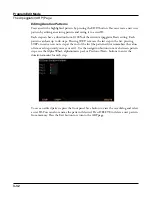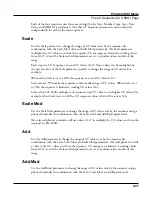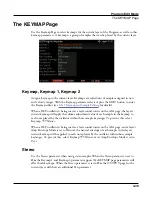
Program Edit Mode
The Arpeggiator (ARP) Page
3-25
Stop
causes the Arpeggiator to stop when it reaches the shift limit.
Reset
causes the Arpeggiator to return to its original pitch and repeat the cycle of notes.
Unipolar
means that after playing up to the shift limit, the Arpeggiator begins shifting
notes in the opposite direction, until it reaches the original pitch, where it reverses again.
To determine the next note when it reaches the shift limit, the Arpeggiator calculates the
interval between the shift limit and what the next note would be if the shift limit weren’t
there. It then plays the note that is the calculated interval lower than the last note before the
shift limit. The same thing happens in reverse when the arpeggiated notes get back down to
the original pitch. The following table makes this easier to visualize by showing the result of
arpeggiating one note (C4) in Unipolar mode, with Shift Amount set to 3 ST and various
values for Shift Limit.
Bipolar
starts out the same way as Unipolar, but during downward note shifting, it continues
past the original pitch until it hits the shift limit in the opposite direction, where it reverses
again.
FloatRst
adds a bit of apparent randomness to the process. “Float” means that when the
Arpeggiator reaches the shift limit, it resets—but not to its original pitch as with plain
Reset. Like Unipolar and Bipolar, it looks at the first note that would exceed the shift limit,
and calculates the interval between that note and the shift limit. It then restarts the cycle of
latched notes, transposing the entire cycle by the interval it just calculated, then shifting each
subsequent cycle by the value of Shift Amount, until it reaches the shift limit again.
Here’s a very simple example. Suppose that the only note in the Arpeggiator cycle is C4,
Shift Amount is 4 (a third), and Shift Limit is 7 (so notes won’t get shifted above G4). The
Arpeggiator plays C4, then E4. The next note should be G
#
4, but that’s above the shift
limit—so the PC4 calculates the difference between that G
#
4 and the shift limit (G4):
one semitone. It adds that difference to the original starting note (C4) and plays that note
next—C
#
4. The next note (F4) is within the shift limit, but the next note (A4) isn’t, so it gets
translated into D4—and so on.
FloatUnip
uses the same concept as FloatRst and applies it to Unipolar mode: when the
Arpeggiator reaches the shift limit, it calculates the difference between the next note and
the limit, and transposes the next cycle of notes down by that interval, then shifts each
subsequent cycle down until it reaches the original pitch.
FloatBip
is similar to FloatUnip, but the downward shift limit isn’t the original pitch, it’s the
negative of the Shift Limit value.
Key Range (Low Key and High Key)
The Arpeggiator processes notes within the range of these parameters. Notes outside the
specified range play normally, and do not become part of the arpeggiation sequence. When
the Low Key or High Key parameter is selected, you can easily set the value by holding the
ENTER button and striking the desired key. Key Range is not saved with each Arp Preset,
but instead is saved as part of each program (or Multi Zone). This allows you to try different
presets while maintaining the same Key Range.
Summary of Contents for Flash Play PC4
Page 1: ... It s the sound Part Number 910587 002 Rev B ...
Page 9: ... ix MIDI Implementation A 1 Specifications B 1 Index I 1 ...
Page 289: ... 8 40 ...
Page 328: ... 10 7 ...
















































